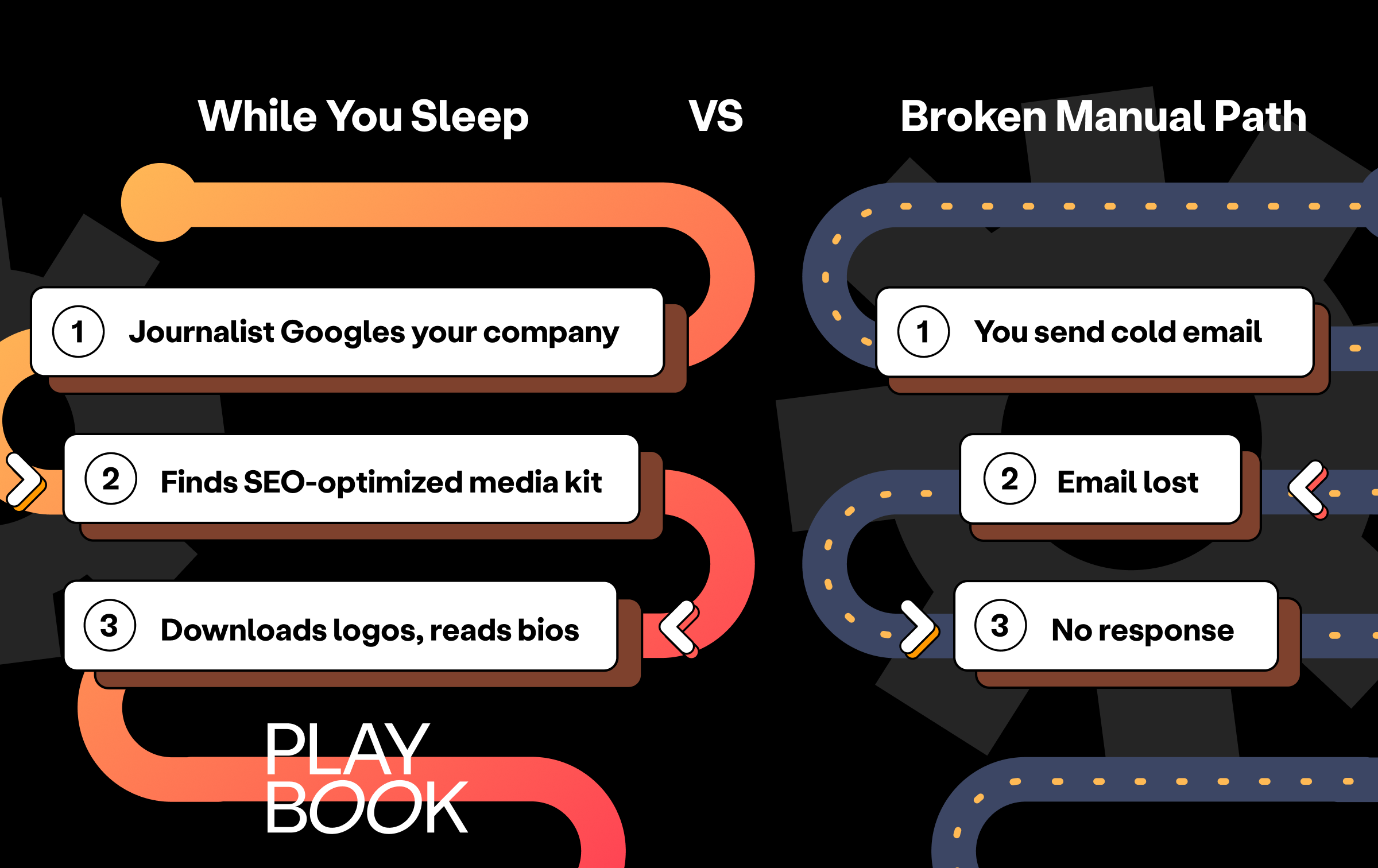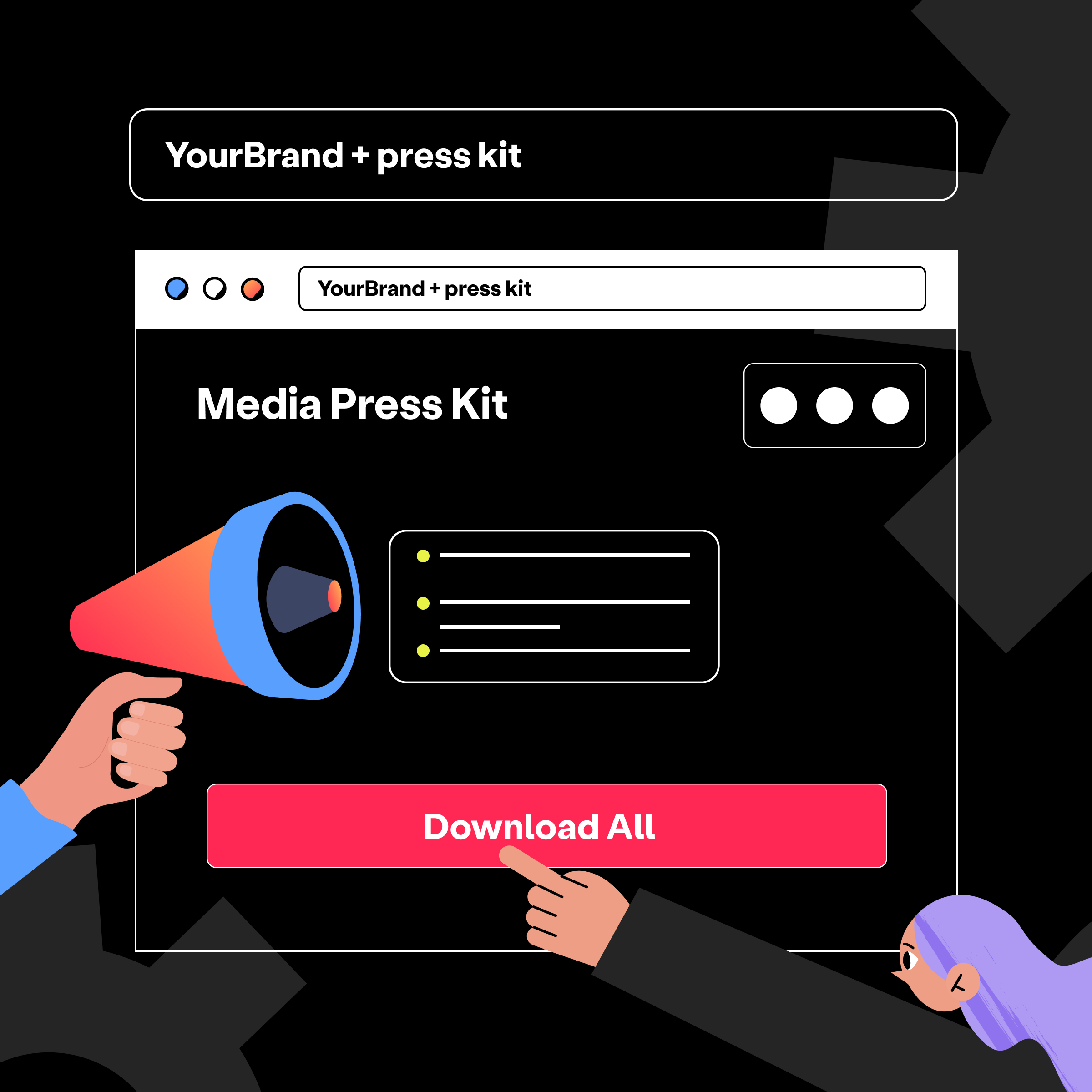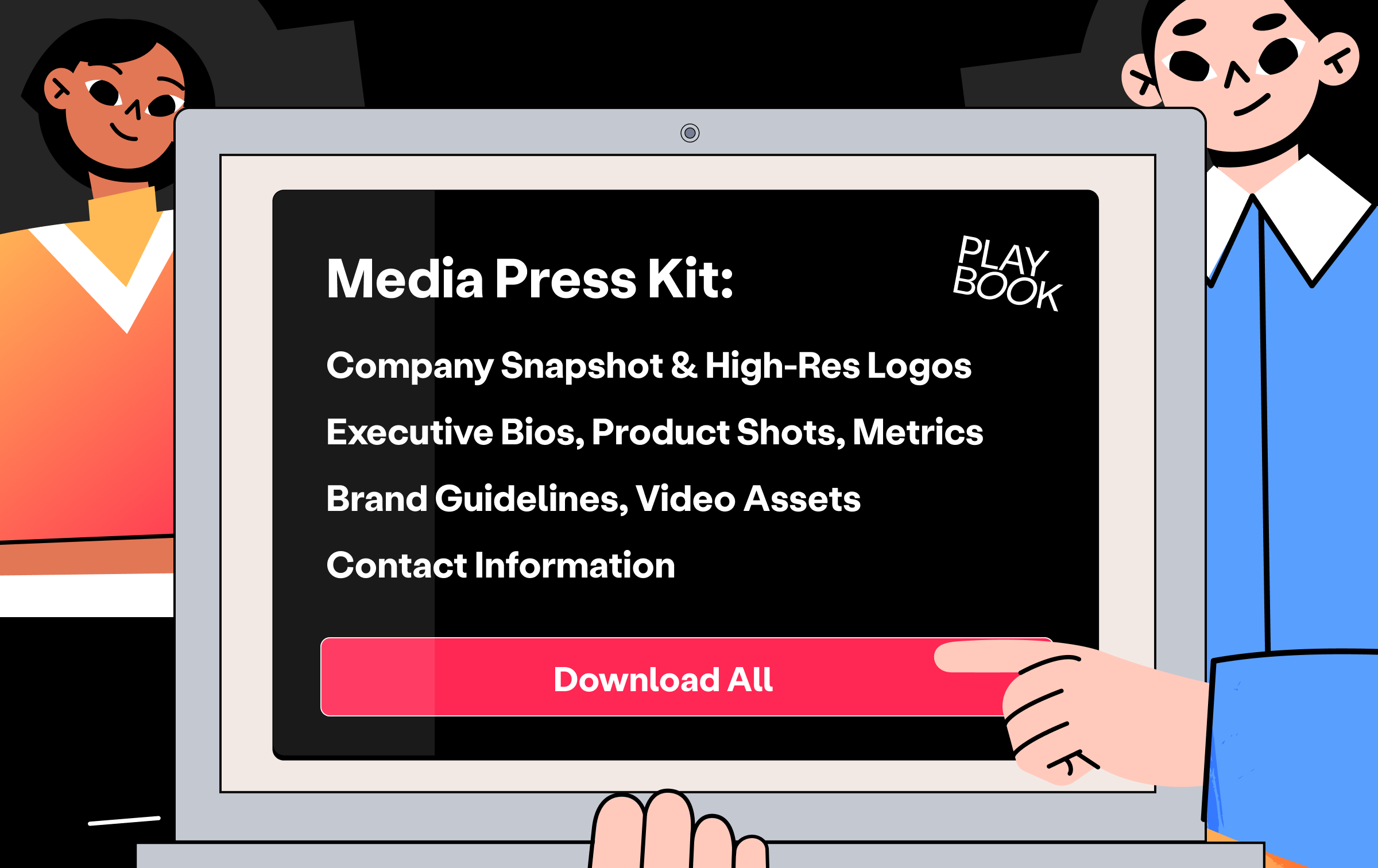The first thing a journalist Googles is your press page. Is it helping or hurting?
At 3 AM, deadline approaching, a journalist needs quick access to your story. Most reporters work under intense time pressure and will move on to the next source if they can't quickly find what they need. Your media kit often becomes the deciding factor between getting coverage and being completely overlooked.
The truth is, most media kits are buried, outdated, or completely non-existent. Companies spend thousands on PR outreach while neglecting the basic infrastructure that supports media relationships. When journalists do find these kits, they're often filled with low-resolution images, outdated bios, and broken download links that send them running to your competition.
While you're pitching via email, your competition is winning with accessible, professional assets. Email pitches get lost in crowded inboxes, but a well-crafted media kit works around the clock. Your competitors with polished, easily accessible media resources are capturing the coverage you're missing out on.
What if your media kit did the heavy lifting while you slept? Imagine waking up to interview requests because journalists discovered your story through search and had everything they needed to move forward immediately.
The Silent Pitch Machine Framework
Think of your media kit as more than a folder of promotional materials. Your media kit should function as a 24/7 sales machine for press coverage, working tirelessly to attract the right attention even when you're focused on other priorities.

Reframe the Mental Model
Most businesses still treat media kits as nice-to-have promotional materials. They create these resources hastily when someone asks for press materials, treating them as reactive afterthoughts. This approach completely misses the enormous opportunity to proactively attract media attention.
Smart companies understand that media kits function as 24/7 sales machines for press coverage. Every element should convince journalists that your story is worth telling while making their job as easy as possible. A strategic media kit anticipates journalist needs and removes every friction point from the coverage process.
The magic happens when you realize that one great media kit generates coverage for months and years. Unlike email pitches that have a single moment of impact, media kits continue working long after you've built them. Journalists bookmark exceptional media kits and return to them for future stories, creating ongoing coverage opportunities that multiply your initial investment.
The Three Pillars of Silent Selling:
Building an effective media kit requires mastering three core principles that work together seamlessly.
- Discoverability means being easy to find and access. Your media kit should rank well in search results and be prominently featured on your website. Journalists should never have to hunt for basic information about your company or struggle to locate high-quality assets when they're working against tight deadlines.
- Shareability: Optimizes everything for quick consumption and redistribution. Every asset should be formatted for immediate use across different media channels. Journalists need options for print, digital, and social media, with clear usage rights and proper file formats that save them precious time.
- Professional Polish: Builds instant credibility. First impressions matter enormously in media relations, and a polished presentation signals that your company is established and worth covering. Professional assets also make journalists' work easier and increase the likelihood of prominent placement in their stories.
Anatomy of a Converting Media Kit
The most effective media kits follow a proven structure that serves journalist needs while building company credibility. Each section works together to create a comprehensive resource that turns casual browsers into engaged storytellers.

Essential Components That Drive Coverage:
The Hero Section
Start with your company snapshot, delivering a one-sentence overview of what you do and why it matters. Think of this as your elevator pitch distilled to its most essential elements. This single sentence often determines whether a journalist continues reading or moves on to the next source.
Your logo variations become crucial when journalists need to fit your brand into their specific layouts. Include PNG, SVG, and EPS files for light and dark backgrounds, plus all orientations. Make it effortless for them to represent your brand properly across any medium.
Team photos should showcase high-quality, authentic portraits and action shots that bring your company's personality to life. Avoid stiff corporate headshots in favor of images that reflect your actual work environment and team dynamics.
Include key metrics that provide clear numbers, awards, or milestones to establish credibility immediately. Journalists love concrete data points that help them frame your company's significance within broader industry contexts.
The Story Arsenal
When crafting executive bios, consider offering multiple lengths that include both personal and professional context. Some journalists need a quick two-sentence summary, while others want detailed background information for feature profiles. Having both options available eliminates the need for back-and-forth requests.
Your company story should share your origin and mission with a clear narrative arc that journalists can easily adapt for their audiences. Focus on the human elements and turning points that make your journey compelling and relatable.
Product overviews need to work for both expert and general readers. Include specific use cases that help journalists understand real-world applications. Technical specifications matter, but so do the problems you solve for actual people.
Keep your latest updates section highlighting recent launches, wins, or newsworthy moments that give journalists current angles for their stories. This section needs regular refreshing because stale information signals that your company might be stagnating.
Visual Assets Library
Your product photos should include both lifestyle shots and detailed product imagery that visually tell your story. Journalists increasingly need compelling visuals to accompany their articles, especially for digital and social media distribution.
Consider adding brand basics, such as your color palette, fonts, and simple style guidelines. These elements help journalists maintain brand consistency when creating their own graphics or presentations featuring your company.
Video content adds another dimension with demos, founder clips, and behind-the-scenes footage that brings depth to written stories. Short, high-quality videos perform especially well on social media and can significantly expand your story's reach.
Transform your key data into clean, shareable infographics that journalists love to include in their coverage. Complex information becomes immediately digestible when presented in well-designed visual formats.
Pro Tips for Each Section:
Every element in your media kit should work seamlessly together to create an experience that journalists find both professional and effortless to navigate.
- Quick-scan formatting: Use clear headings, bullet points, and white space that make information easy to consume rapidly. Journalists often skim content first, so your formatting should support quick comprehension and easy navigation to relevant details.
- Smart file naming: Follow patterns that journalists love by using descriptive, consistent names that include your company name and content description. Avoid generic names like "logo1.jpg" in favor of specific names like "CompanyName_Logo_Horizontal_HighRes.png" that make organization and usage effortless.
- Mobile-first design: Ensure your media kit works perfectly on phones and tablets since many journalists work from mobile devices. Test loading speeds, image display, and navigation across various devices to guarantee accessibility everywhere.
- Search-friendly content: Write descriptions and alt text that help with discovery while providing context for journalists. Include relevant keywords naturally while maintaining readability and usefulness for human users who need to understand your content quickly.
Media Kit Templates & Examples Breakdown
Different types of businesses need different approaches to media kit organization and content emphasis. Your industry and company stage determine which elements deserve the most prominent placement and detailed development.

For Content Creators & Influencers
- Personal branding focus. Content creators need media kits that emphasize personal branding, focusing on personality, values, and unique perspective that differentiates them from others in their space. Your media kit should reflect your authentic voice and demonstrate the engaging personality that attracts your audience organically.
- Collaboration packages and rates. Clear collaboration packages and rates help streamline partnerships by outlining your services, typical project timelines, and transparent pricing structures. This information helps potential partners evaluate fit quickly and reduces back-and-forth negotiations by establishing clear expectations upfront.
- Audience demographics and engagement stats. Include detailed audience demographics and engagement stats covering age ranges, locations, interests, and engagement rates. Brands need this data to assess alignment with their target markets and justify partnership investments to their stakeholders.
- Content style examples and brand partnerships. Showcase your range with content style examples and successful brand partnerships. Include diverse content types and demonstrate your ability to maintain authenticity while incorporating brand messaging effectively.
For Startups & Tech Companies
- Product-focused layouts. Startups benefit from product-focused layouts that lead with clear demonstrations and technical specifications helping journalists understand your innovation. Include comparison charts, feature lists, and use case scenarios that make complex technology accessible to general audiences.
- Founder story emphasis. The founder story often drives media interest more than product features alone. Highlight the personal journey and expertise that led to your company's creation, including background information that establishes credibility and explains the passion driving your business vision.
- Technical specifications and use cases. Balance technical depth with accessibility by providing detailed product information for technical journalists while including simplified explanations for general business media. Cover integration capabilities, security features, and scalability to address common technical journalism questions proactively.
- Investor and partnership information. Your investor and partnership information tells a story of validation and growth. Include funding history, notable investors, and strategic partnerships that help business journalists understand your company's trajectory and market position within broader industry trends.
For Established Brands
- Corporate-level assets. Established companies need comprehensive corporate-level assets that reflect their scale and market position while remaining accessible to journalists. Provide detailed company history, executive leadership information, and corporate social responsibility initiatives that demonstrate your broader impact.
- Multiple product lines organization. When managing multiple product lines, structure information clearly using intuitive navigation and clear categorization. Help journalists quickly find information relevant to their specific story focus without overwhelming them with irrelevant details.
- Executive team spotlights. Your executive team becomes a valuable resource when positioned correctly. Feature key leaders with detailed backgrounds, expertise areas, and availability for interviews or expert commentary. Position your executives as thought leaders and reliable sources for industry insights and trend analysis.
- Historical timeline and evolution. Document your evolution through a historical timeline that captures your company's growth story, major milestones, and market impact over time. This historical context helps journalists understand your significance within industry development and provides rich material for feature stories.
The Playbook Advantage: Building Your Media Kit
Creating a professional media kit used to require design expertise, technical knowledge, and significant time investment. Playbook changes that equation completely, putting professional-grade tools within reach of any creative professional or growing business.
Design Without a DesignerUse polished, professional templates with zero design skills required. Drag, drop, and customize layouts with complete ease. Everything stays visually consistent, from fonts to colors, automatically maintaining professional standards throughout your entire kit. Mobile-friendly optimization comes built right into the foundation, so your kit looks perfect everywhere.
Collaborative & Always CurrentInvite team members to edit and approve content seamlessly. Version control keeps everything updated without confusion or conflicting files. Real-time syncing means your kit always reflects the latest information, anywhere it lives across the web.
Simple to Share and EmbedGenerate public links, embed directly into your website, or export assets as needed for different platforms. Updates appear instantly everywhere, keeping your media presence perfectly aligned across all touchpoints.
Built for Search and Share
Playbook’s smart search and sorting tools make it easy for collaborators, partners, and press to find exactly what they need fast. Assets can be filtered by tags, content type, or date, giving visitors an intuitive experience. With built-in analytics, you can also track views and downloads to understand how your kit is performing and who’s engaging with it.
Turn Attention Into Action
Your media kit shouldn't be an afterthought when you're serious about being seen. With Playbook, you can create a professional, journalist-ready press kit in just a few focused steps. No design experience needed. No delays waiting on developers or external contractors.
Use our plug-and-play template to launch a polished, mobile-optimized media kit that reflects your brand at its absolute best. Everything comes already structured for what journalists actively look for: logos, bios, photography, contact details, and recent news organized in logical, scannable sections.
Here's what you get when you choose Playbook:
- A clean, on-brand kit live in minutes
- Built-in mobile
- Real-time updates and team collaboration
- Analytics to see who’s engaging with your content
Start strong. Get noticed. Be ready.
Get Your Press Kit Template NowAdditional Resources:
- Media kit examples from leading brands
- A downloadable brand asset checklist
- Email templates for effective press outreach
- Tools to help you find the right journalist contacts
